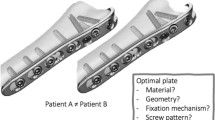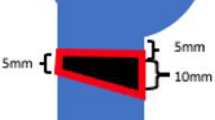Abstract
Pseudoelastic NiTiNOL presents an attractive material option for devices used in clinical orthopaedic applications. The capacity of the material to exert sustained compression during shape recovery aligns well with the mechanobiological factors associated with bone healing, particularly in applications such as fracture healing and joint fusion. Orthopaedic medical devices which have incorporated NiTiNOL are increasing in number, with two noted examples including staples and intramedullary nails. Early NiTiNOL devices utilized shape memory NiTiNOL, but the logistical difficulties with maintaining a cold state in the clinic or limited force-generation for materials warmed from room temperature to body temperature have led to pseudoelastic NiTiNOL devices dominating clinical usage. Both pre-clinical biomechanical and clinical studies have shown that these devices do exert sustained compression beyond the abilities of competing static devices, and largely have resulted in superior clinical outcomes, such as higher fusion rates and faster times to fusion. Given these results, continued adoption of existing NiTiNOL devices and future development of new orthopaedic devices utilizing the material should continue.






Similar content being viewed by others
References
Hughes JL (1976) Evaluation of nitinol for use as a material in the construction of orthopaedic implants. US Army Medical Research and Development, Fredrick
Simon M et al (1977) A vena cava filter using thermal shape memory alloy. Exp Aspects Radiol 125(1):87–94
Carter DR et al (1998) Mechanobiology of skeletal regeneration. Clin Orthop Relat Res 355:S41–55
Allori AC et al (2008) Biological basis of bone formation, remodeling, and repair-part III: biomechanical forces. Tissue Eng Part B 14(3):285–293
Robling AG, Castillo AB, Turner CH (2006) Biomechanical and molecular regulation of bone remodeling. Annu Rev Biomed Eng 8:455–498
Rosa N et al (2015) From mechanical stimulus to bone formation: a review. Med Eng Phys 37(8):719–728
Liu C et al (2018) Effects of mechanical loading on cortical defect repair using a novel mechanobiological model of bone healing. Bone 108:145–155
Charnley J (1951) Compression arthrodesis of the ankle and shoulder. J Bone Joint Surg Br 33B(2):180–191
Muckley T et al (2007) Biomechanical evaluation of primary stiffness of tibiotalocalcaneal fusion with intramedullary nails. Foot Ankle Int 28(2):224–231
Parker L, Singh D (2009) The principles of foot and ankle arthrodesis. Orthop Trauma 23(6):385–394
Evers J et al (2017) 3D optical investigation of 2 nail systems used in tibiotalocalcaneal arthrodesis: a biomechanical study. Foot Ankle Int 38(5):571–579
Claes L, Eckert-Hubner K, Augat P (2003) The fracture gap size influences the local vascularization and tissue differentiation in callus healing. Langenbecks Arch Surg 388(5):316–322
Jagodzinski M, Krettek C (2007) Effect of mechanical stability on fracture healing–an update. Injury 38(Suppl 1):S3–10
Yamaji T et al (2001) The effect of micromovement on callus formation. J Orthop Sci 6(6):571–575
Wehner T et al (2011) Improvement of the shear fixation stability of intramedullary nailing. Clin Biomech 26(2):147–151
Knothe U, Tate ML, Perren SM (2000) 300 Years of Intramedullary Fixation – from Aztec Practice to Standard Treatment Modality. European Journal of Trauma 26:217–225
Rosa N et al (2017) Recent developments on intramedullary nailing: a biomechanical perspective. Ann N Y Acad Sci 1408(1):20–31
Yakacki CM et al (2010) Compression forces of internal and external ankle fixation devices with simulated bone resorption. Foot Ankle Int 31(1):76–85
Yakacki CM et al (2011) Pseudoelastic intramedullary nailing for tibio-talo-calcaneal arthrodesis. Exp Rev Med Dev 8(2):159–166
Taylor J et al (2016) Tibiotalocalcaneal arthrodesis nails: a comparison of nails with and without internal compression. Foot Ankle Int 37(3):294–299
Griffin MJ, Coughlin MJ (2018) Evaluation of midterm results of the panta nail: an active compression tibiotalocalcaneal arthrodesis device. J Foot Ankle Surg 57(1):74–80
Anderson R et al (2016) Finite element analysis of a pseudoelastic compression-generating intramedullary ankle arthrodesis nail. J Mech Behav Biomed Mater 62:83–92
Karakasli A, Satoglu IS, Havitcioglu H (2015) A new intramedullary sustained dynamic compression nail for the treatment of long bone fractures: a biomechanical study. Eklem Hastalik Cerrahisi 26(2):64–71
Mueckley TM et al (2006) Biomechanical evaluation of primary stiffness of tibiotalar arthrodesis with an intramedullary compression nail and four other fixation devices. Foot Ankle Int 27(10):814–820
Morgan NB (2004) Medical shape memory alloy applications - the market and its products. Mater Sci Eng, A 378:16–23
Machado LG, Savi MA (2003) Medical applications of shape memory alloys. Braz J Med Biol Res 36(6):683–691
Gabarre S et al (2017) Influence of gap size, screw configuration, and nail materials in the stability of anterograde reamed intramedullary nail in femoral transverse fractures. Injury 48(Suppl 6):S40–S46
Yakacki CM et al (2017) Patient-specific finite-element analysis of three intramedullary nails for tibiotalocalcaneal fusion. In: AOFAS annual meeting. 2017: Seattle, WA
Kujala S et al (2002) Bone modeling controlled by a nickel-titanium shape memory alloy intramedullary nail. Biomaterials 23(12):2535–2543
Firoozbakhsh K et al (2004) Smart intramedullary rod for correction of pediatric bone deformity: a preliminary study. Clin Orthop Relat Res 424:194–201
Assad M et al (2003) Porous titanium-nickel for intervertebral fusion in a sheep model: part 2. Surface analysis and nickel release assessment. J Biomed Mater Res B 64(2):121–129
Assad M et al (2003) (2003) Porous titanium-nickel for intervertebral fusion in a sheep model: part 1. Histomorphometric and radiological analysis. J Biomed Mater Res B 64(2):107–120
Russell SM (2009) Design considerations for nitinol bone staples. J Mater Eng Perform 18(5–6):831–835
Knight A et al (2013) Method and apparatus for an orthopedic fixation system. BioMedical Enterprises: USPTO 8584853B2.
Cheney D (2018) Elastic orthopedic implant and method of manufacturing thereof. BioMedical Enterprises: USPTO 10117647B2
Cheney D (2014) Bonestaples and methods of use therefor and manufacturing thereof. BioMedical Enterprises: USPTO US2014/0276830
Mereau TM, Ford TC (2006) Nitinol compression staples for bone fixation in foot surgery. J Am Podiatr Med Assoc 96(2):102–106
Neufeld SK, Parks BG, Naseef GS, Melamed EA, Schon LC (2002) Arthrodesis of the first metatarsophalangeal joint: a biomechanical study comparing memory compression staples, cannulated screws, and a dorsal plate. Foot Ankle Int 23(2):97–101
Shibuya N et al (2007) A compression force comparison study among three staple fixation systems. J Foot Ankle Surg 46(1):7–15
Farr D et al (2010) A biomechanical comparison of shape memory compression staples and mechanical compression staples: compression or distraction? Knee Surg Sports Traumatol Arthrosc 18(2):212–217
Chang TJ, Overley BD, Pancratz D (2008) An in vitro comparative study of screw and nitinol staple compression: a model showing active dynamic compression. The Podiatry Institute Update Textbooks, Decatur
Russell NA et al (2015) Evaluation of nitinol staples for the lapidus arthrodesis in a reproducible biomechanical model. Front Surg 2:65
Aiyer A et al (2016) The impact of nitinol staples on the compressive forces, contact area, and mechanical properties in comparison to a claw plate and crossed screws for the first tarsometatarsal arthrodesis. Foot Ankle Spec 9(3):232–240
Hoon QJ et al (2016) Biomechanical evaluation of shape-memory alloy staples for internal fixation-an in vitro study. J Exp Orthop 3(1):19
McKnight RR, Lee SK (2019) Biomechanical properties of nitinol staples: effects of troughing, effective leg length, and 2-staple constructs. J Hand Surg Am 44(6):520
Zhou PY et al (2019) Nickel-titanium arched shape-memory alloy connector combined with bone grafting in the treatment of scaphoid nonunion. Eur J Med Res 24(1):27
Malal JJ, Hegde G, Ferdinand RD (2006) Tarsal joint fusion using memory compression staples–a study of 10 cases. J Foot Ankle Surg 45(2):113–117
Fernandez-de-Retana P, Poggio D, Ortega JP (2008) Technical tip: first metatarsophalangeal arthrodesis with 20-mm memory compression staples. Foot Ankle Int 29(6):613–615
Choudhary RK, Theruvil B, Taylor GR (2004) First metatarsophalangeal joint arthrodesis: a new technique of internal fixation by using memory compression staples. J Foot Ankle Surg 43(5):312–317
Mallette JP, Glenn CL, Glod DJ (2014) The incidence of nonunion after lapidus arthrodesis using staple fixation. J Foot Ankle Surg 53(3):303–306
Schipper ON et al (2018) Radiographic results of nitinol compression staples for hindfoot and midfoot arthrodeses. Foot Ankle Int 39(2):172–179
Schipper ON, Ellington JK (2019) Nitinol compression staples in foot and ankle surgery. Orthop Clin N Am 50(3):391–399
Wu JC et al (2019) Fracture fixation using shape-memory (ninitol) staples. Orthop Clin N Am 50(3):367–374
Bennett GL et al (2005) Tibiotalocalcaneal arthrodesis: a biomechanical assessment of stability. Foot Ankle Int 26(7):530–536
Jehan S et al (2011) The success of tibiotalocalcaneal arthrodesis with intramedullary nailing–a systematic review of the literature. Acta Orthop Belg 77(5):644–651
Dupont KM, Shibuya N, Bariteau JT (2019) Tibiotalocalcaneal arthrodesis with intramedullary nails—mechanobiological background and evolution of compressive technology. Glob J Ortho Res 1(5):873–884
Jeng CL et al (2013) Tibiotalocalcaneal arthrodesis with bulk femoral head allograft for salvage of large defects in the ankle. Foot Ankle Int 34(9):1256–1266
Bussewitz B et al (2014) Retrograde intramedullary nail with femoral head allograft for large deficit tibiotalocalcaneal arthrodesis. Foot Ankle Int 35(7):706–711
Ford SE, Kwon JY, Ellington JK (2019) Tibiotalocalcaneal arthrodesis utilizing a titanium intramedullary nail with an internal pseudoelastic nitinol compression element: a retrospective case series of 33 patients. J Foot Ankle Surg 58(2):266–272
Steele JR et al (2019) Comparison of tibiotalocalcaneal arthrodeses using a sustained dynamic compression nail versus nondynamized nails. Foot Ankle Spec 13:193–200
Berson L, McGarvey WC, Clanton TO (2002) Evaluation of compression in intramedullary hindfoot arthrodesis. Foot Ankle Int 23(11):992–995
Hsu AR, Ellington JK, Adams SB Jr (2015) Tibiotalocalcaneal arthrodesis using a nitinol intramedullary hindfoot nail. Foot Ankle Spec 8(5):389–396
Kinmon K et al (2013) Benchtop comparison of a novel dynamic compression screw to a standard cortical screw: compression integrity and gap size over time during simulated resorption. Foot Ankle Spec 6(3):222–225
Conklin MJ et al (2019) Total ankle replacement conversion to tibiotalocalcaneal arthrodesis with bulk femoral head allograft and pseudoelastic intramedullary nail providing sustained joint compression. Foot Ankle Orthopaedics 3(4):1–7
Dekker TJ et al (2018) Use of patient-specific 3D-printed titanium implants for complex foot and ankle limb salvage, deformity correction, and arthrodesis procedures. Foot Ankle Int 39(8):916–921
Kildow BJ et al (2016) Measurement of nitinol recovery distance using pseudoelastic intramedullary nails for tibiotalocalcaneal arthrodesis. Foot Ankle Spec 9(6):494–499
Kreulen C, Lian E, Giza E (2017) Technique for use of trabecular metal spacers in tibiotalocalcaneal arthrodesis with large bony defects. Foot Ankle Int 38(1):96–106
Lachman JR, Adams SB (2019) Tibiotalocalcaneal arthrodesis for severe talar avascular necrosis. Foot Ankle Clin 24(1):143–161
Latt LD, Smith KE, Dupont KM (2017) Revision tibiotalocalcaneal arthrodesis with a pseudoelastic intramedullary nail: a case study. Foot Ankle Spec 10(1):75–81
Zhao X et al (2012) Nickel-titanium shape-memory sawtooth-arm embracing fixator for periprosthetic femoral fractures. Int Orthop 36(3):619–626
Chen X et al (2013) Design and application of nickel-titanium olecranon memory connector in treatment of olecranon fractures: a prospective randomized controlled trial. Int Orthop 37(6):1099–1105
Chan WY et al (2018) Mechanical and clinical evaluation of a shape memory alloy and conventional struts in a flexible scoliotic brace. Ann Biomed Eng 46(8):1194–1205
Abduljabbar FH et al (2017) Factors associated with clinical outcomes after lumbar interbody fusion with a porous nitinol implant. Glob Spine J 7(8):780–786
Ferrier M et al (2019) Radiographic and clinical comparison of proximal interphalangeal joint arthrodesis between a static and dynamic implant. J Foot Ankle Surg 58(4):657–662
Payo-Ollero J et al (2019) The efficacy of an intramedullary nitinol implant in the correction of claw toe or hammertoe deformities. Arch Orthop Trauma Surg 139(12):1681–1690
Acknowledgements
The authors gratefully acknowledge Dr. Jeffrey D. Seybold, M.D., and Dr. L. Daniel Latt, M.D., Ph.D., for use of clinical images.
Author information
Authors and Affiliations
Corresponding author
Additional information
Publisher's Note
Springer Nature remains neutral with regard to jurisdictional claims in published maps and institutional affiliations.
This invited article is part of a special issue of Shape Memory and Superelasticity to honor Prof. Dr.-Ing. Gunther Eggeler. This special issue was organized by Prof. Hüseyin Sehitoglu, University of Illinois at Urbana-Champaign, and Prof. Dr.-Ing. Hans Jürgen Maier, Leibniz Universität Hannover.
Rights and permissions
About this article
Cite this article
Safranski, D., Dupont, K. & Gall, K. Pseudoelastic NiTiNOL in Orthopaedic Applications. Shap. Mem. Superelasticity 6, 332–341 (2020). https://doi.org/10.1007/s40830-020-00294-y
Published:
Issue Date:
DOI: https://doi.org/10.1007/s40830-020-00294-y




